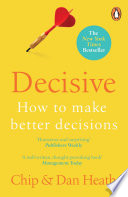

The authors, Chip and Dan Heath, identify four common biases that sabotage effective decision-making: narrow framing, confirmation bias, short-term emotion, and overconfidence. Narrow framing occurs when we limit our options and focus on a binary choice, ignoring alternatives that might yield better outcomes. Confirmation bias leads us to seek out information that supports our existing beliefs while disregarding contradictory data. Short-term emotion can cloud our judgment, causing us to make impulsive decisions based on fleeting feelings rather than rational analysis. Lastly, overconfidence can lead us to underestimate risks and overestimate our ability to predict future events. Understanding these villains is crucial as it allows us to recognize when they are influencing our decisions and take steps to mitigate their effects.
Continue readingOne of the key strategies the authors propose is to expand the range of options considered before making a decision. This involves moving beyond the binary choices that often dominate our thinking. The Heath brothers suggest techniques such as brainstorming multiple alternatives, considering the 'vanishing options' test—where one imagines that all but one option has been eliminated—and using 'what-if' scenarios to explore possibilities. By widening our options, we can avoid the trap of making decisions based solely on immediate choices and instead arrive at more thoughtful and comprehensive solutions.
Continue readingThe book emphasizes the importance of testing our assumptions rather than taking them at face value. This involves gathering data, seeking feedback, and conducting experiments to validate our beliefs. The authors recommend using a technique called 'pre-mortem' analysis, where individuals envision a future failure and work backward to determine what could lead to that outcome. This exercise helps in identifying potential pitfalls and encourages critical thinking about the decision at hand. By reality-testing our assumptions, we can make more informed decisions that are grounded in evidence rather than speculation.
Continue readingAcknowledging that we are likely to make mistakes is a cornerstone of effective decision-making. The Heath brothers argue for the importance of creating a decision-making environment that anticipates failure and prepares for it. This can involve setting up contingency plans, establishing clear criteria for success, and being willing to pivot when things don’t go as expected. By embracing the possibility of being wrong, we can reduce the fear of failure and instead focus on adaptability and learning from our experiences, which ultimately leads to better decision outcomes.
Continue readingThe authors introduce a systematic approach to decision-making, which they refer to as the 'WRAP' process: Widen your options, Reality-test your assumptions, Attain distance before deciding, and Prepare to be wrong. This framework serves as a guide for individuals and organizations to follow when faced with challenging decisions. By adhering to this structured approach, decision-makers can ensure that they are considering a broad range of factors, testing their ideas rigorously, and maintaining perspective, which enhances the likelihood of making sound choices that lead to successful outcomes.
Continue readingEmotional responses can heavily influence our decision-making processes. The Heath brothers suggest that taking a step back from the immediate situation can provide clarity and perspective. Techniques such as visualizing the decision as if it were someone else's problem, or considering how you would advise a friend in the same situation, can help in reducing emotional bias. This distance allows for a more objective analysis of the options available, leading to decisions that are less swayed by transient feelings and more aligned with long-term goals.
Continue readingGroup dynamics play a significant role in decision-making. The authors highlight the benefits of collaborative decision-making processes, where diverse perspectives can lead to more innovative and effective solutions. They caution against groupthink, where the desire for harmony in a group leads to poor decisions. To counteract this, the Heath brothers recommend techniques such as assigning a devil’s advocate to challenge prevailing opinions and ensuring that all voices are heard in the discussion. By valuing group input and fostering an inclusive decision-making environment, organizations can enhance the quality of their decisions.
Continue reading